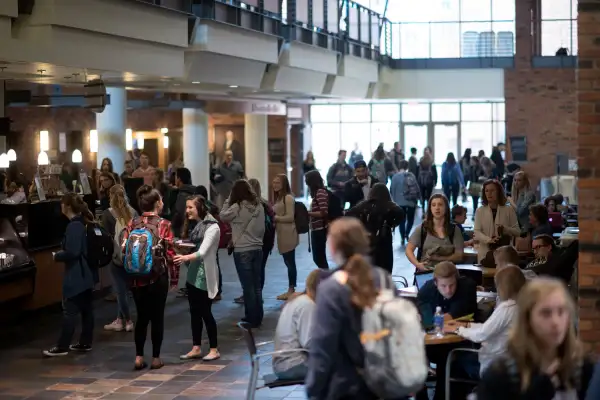The 10 Most Improved Colleges of 2016

A handful of colleges improved their standing dramatically in Money’s latest Best Colleges rankings, released on Monday.
Among the reasons: lower prices for families, higher graduation rates, and increases in average alumni earnings, to name a few.
What could other colleges do to follow their example?
“There’s no magic bullet,” says Sean O’Connell, vice president of academic affairs at Albertus Magnus College, a private liberal arts school in Connecticut that improved its ranking this year by more than 400 spots. Albertus Magnus and other colleges that saw dramatic one-year jumps didn't turn around overnight. Instead, they cite wide-ranging, multiyear initiatives around goals such as improving retention rates, increasing financial aid, and improving career counseling.
See the full 2016 Best Colleges rankings.
Many of the most-improved group also benefited from changes to the Best Colleges methodology this year. Money added, for example, new data from the federal College Scorecard on student-loan repayment rates and the salaries of federal loan borrowers who are now out in the workplace.
Yet what appears to have carried the most weight is a new metric we added to assess student outcomes: job meaning. Nearly all the colleges with large jumps scored comparatively high in that category, based on the share of alumni who said they felt their job was making the world a better place in a Payscale.com survey.
Because of those methodology changes we're not calling out the colleges that dropped the most this year. In most cases, they moved down in the rankings not because their statistics got worse, but because we changed how we weighted them.
Here's a look at the three colleges that jumped the highest, plus a list of other most improved colleges.
Albertus Magnus College
2016 rank: 178
2015 rank: 608
Spots climbed: 430
Five years ago, most campus departments at New Haven’s Albertus Magnus College were what O’Connell calls “cubbyholed.” For career services, students went to the student services offices. For help finding and applying to internships, they went to academic advising. The two related services rarely communicated.
Not anymore. Now they’re under a common umbrella in the new Center for Teaching and Learning Excellence.
The creation of the center was one of several changes the private Catholic liberal arts school has implemented to improve its curriculum and support services, O’Connell says. It also created a peer mentoring program and boosted its internship program. Two grants totaling more than $200,000 also helped the college design an e-portfolio system and put more resources into professional development for faculty, especially around using technology in instruction.
That work is showing results in Money’s rankings.
Albertus Magnus primarily serves first-generation students, and it works to keep its price roughly equal to what they’d pay at public colleges in the state. About 80% of students receive aid from the college. The college does extremely well in Money’s comparative value-add factors, which measure how much better (or worse) than expected a school's students do, based on their economic background and academic preparation.
The college's six-year graduation rate has climbed from 42.5% to about 50%, which is a whopping 77% better than expected. Graduates’ average early career earnings also increased $8,000, to $48,000 a year, as the school focused more on career prep and placement. Five years ago, about 55% of students participated in internships. Now that number is about 75%, O’Connell says.
Finally, about two-thirds of graduates said their job makes the world a better place—that’s higher than all but 20 of 635 colleges for which Money has data.
But O’Connell isn’t sure Albertus Magnus can take all—or even most—of the credit for that metric. There’s certainly a lot of emphasis on social justice and responsibility on campus, he says. But it also might be explained simply by the type of student the college attracts.
“They’re looking for the personal interaction, and they don’t want to be a number,” he says. “ I think that’s the type of person who’s interested in other people and in helping other people.”
Lewis & Clark College
2016 rank: 261
2015 rank: 681
Spots climbed: 420
The six-year graduation rate at Lewis & Clark College has climbed to 79%, from 73%, in part because the college has put greater emphasis on addressing students’ individual reasons for leaving before they earn a degree.
“It’s never that there’s one reason that students don’t return,” says Lisa Meyer, dean for enrollment and communications at the Portland, Ore., college. “And we’re lucky that we’re a small liberal arts college and we can give that personal attention.”
Students now benefit from a two-pronged advising approach: They’re assigned both a faculty mentor in their academic field and a traditional academic adviser. And they're required to meet with those advisers at least once a semester to sign off on their upcoming course schedule.

The college has also increased the number of living learning communities, where students live in residential halls with peers who have like interests, such as foreign languages or civil justice. That can help students make connections and feel part of a community, Meyer says.
Like the other colleges on this most-improved list, Lewis & Clark benefited from its comparatively high scores on measures that are new to the rankings. For example, a relatively high 96%-plus of its borrowers have made progress in paying down their loans within five years of leaving school, according to the federal College Scorecard. One reason may be that every student at the college has access to SALT, a financial literacy program designed for college students; more than 2,000 Lewis & Clark students have taken advantage of it so far.
Bethel University
2016 rank: 82
2015 rank: 451
Spots climbed: 369
As part of its ongoing "Moving the Needle" project on student success and retention, this private Christian college in Minnesota increased training for academic advisers to make sure students stay on track to graduate. Advisers also trained peer mentors in the college of business, so that each freshman business major meets with an older student who can walk him or her through the course tracking system. (Business is the college’s most popular major.)
To keep the cost of a degree down, Bethel University's advisers often help students and parents find creative ways to finish a degree quicker than in four years, says Deb Sullian-Trainor, vice president and dean for the College of Arts & Sciences. That’s possible, in part, because of Minnesota’s statewide Postsecondary Enrollment Options, which allows high schoolers to earn college credit. Bethel even created a new position last year in its advising office to work directly with high school students who have questions about the best courses to take for their future plans. The college also increased its summer courses, which are less expensive than than those in the fall and spring and can be taken online while the student is home for the summer.
Bethel’s 95% student debt repayment rate for recent graduates is 6% higher than would be expected based on the school's student body, about 30% of which qualify for low-income grants from the federal government.
Where Bethel stands out the most in Money's analysis, though, is job meaning. Sixty-eight percent of graduates said their job made the world a better place, the 11th-highest job meaning score of all the colleges in our rankings.
Like O'Connell at Albertus Magnus, Sullivan-Trainor thinks a big reason is the type of student who enrolls at Bethel. One of the college's values is to prepare students to be "world changers," so there's a lot of emphasis on helping them figure out how they can make difference, she says. Plus, they are taught to think about their work as part of worshiping God, no matter what it is. “That underlying value and perspective makes a difference,” she says.
| 2016's Most Improved Colleges |
| College | 2016 rank | 2015 rank | # of Spots Climbed | Job Meaning Score | Noteworthy Data |
|---|---|---|---|---|---|
| Albertus Magnus College | 178 | 608 | 430 | 66.7% | Average early career earnings reported to Payscale.com increased from $40,000, to $48,000 |
| Lewis & Clark College | 261 | 681 | 420 | 63.8% | 96% student loan repayment rate is in the top 75 of all colleges |
| Bethel University | 82 | 451 | 369 | 67.7% | Doubled the number of career services staff per 1000 students, from 1.2 to 2.4 |
| Nebraska Wesleyan University | 218 | 573 | 355 | 65.2% | Average student debt decreased from $21,229 to $19,402 |
| Bethel College-Indiana | 274 | 625 | 351 | 59.3% | Graduation rate increased from 62% to 72% |
| Morehouse College | 367 | 713 | 346 | 60% | Average student debt decreased from $26,990 to $22,072 |
| Earlham College | 28 | 367 | 339 | 80% | 2nd-highest job meaning score |
| South Carolina State University | 375 | 710 | 335 | 77.8% | 3rd-highest job meaning score |
| University of Minnesota-Morris | 232 | 566 | 334 | 65% | Graduation rate increased from 63.4% to 66.8% |
| Huntington University | 341 | 668 | 327 | N/A | Average mid-career earnings increased from $55,600 to $62,000, according to Payscale.com |
For more of Money’s Best Colleges 2016-2017 coverage, check out:
- Money’s 2016 Best Value Colleges
- No Matter Who’s Paying the Bill, College is More Expensive Than You Think
- The Affordable College Finder Tool
